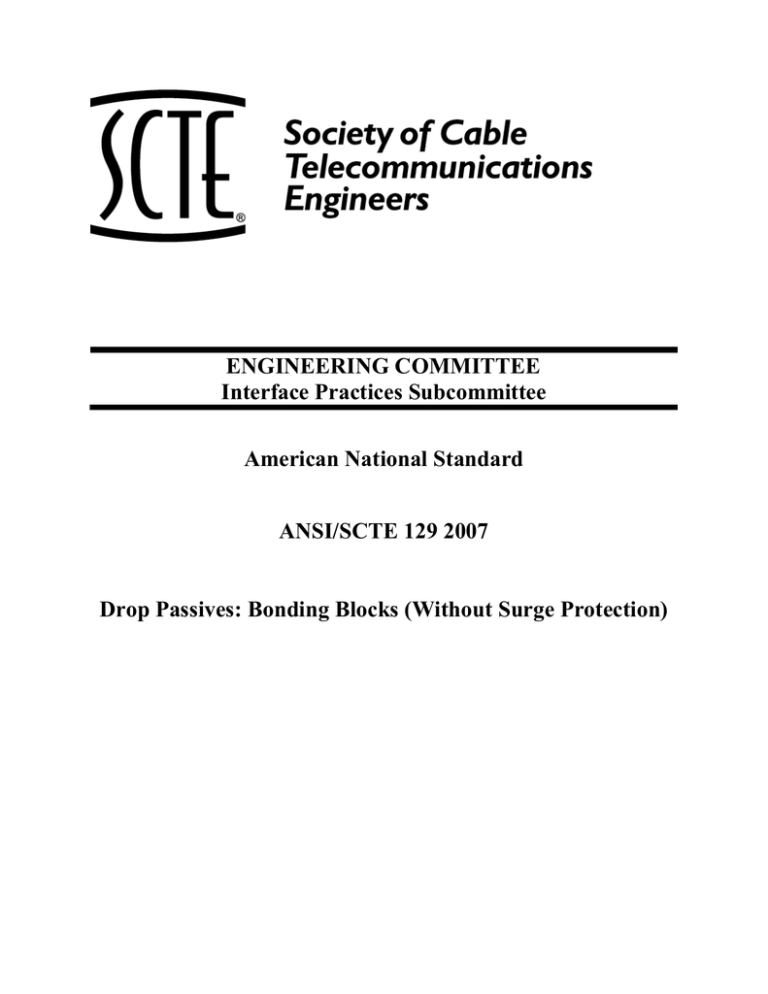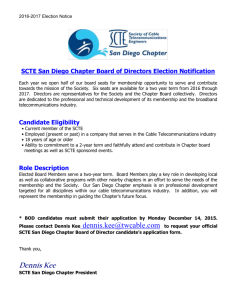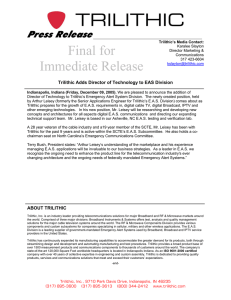
ENGINEERING COMMITTEE
Interface Practices Subcommittee
American National Standard
ANSI/SCTE 129 2007
Drop Passives: Bonding Blocks (Without Surge Protection)
NOTICE
The Society of Cable Telecommunications Engineers (SCTE) Standards are intended to serve the
public interest by providing specifications, test methods and procedures that promote uniformity
of product, interchangeability and ultimately the long term reliability of broadband
communications facilities. These documents shall not in any way preclude any member or
nonmember of SCTE from manufacturing or selling products not conforming to such documents,
nor shall the existence of such standards preclude their voluntary use by those other than SCTE
members, whether used domestically or internationally.
SCTE assumes no obligations or liability whatsoever to any party who may adopt the Standards.
Such adopting party assumes all risks associated with adoption of these Standards or
Recommended Practices, and accepts full responsibility for any damage and/or claims arising
from the adoption of such Standards or Recommended Practices.
Attention is called to the possibility that implementation of this standard may require use of
subject matter covered by patent rights. By publication of this standard, no position is taken with
respect to the existence or validity of any patent rights in connection therewith. SCTE shall not
be responsible for identifying patents for which a license may be required or for conducting
inquires into the legal validity or scope of those patents that are brought to its attention.
Patent holders who believe that they hold patents which are essential to the implementation of
this standard have been requested to provide information about those patents and any related
licensing terms and conditions. Any such declarations made before or after publication of this
document are available on the SCTE web site at http://www.scte.org.
All Rights Reserved
© Society of Cable Telecommunications Engineers, Inc. 2007
140 Philips Road
Exton, PA 19341
i
TABLE OF CONTENTS
1.0
2.0
3.0
4.0
5.0
SCOPE .............................................................................................1
MECHANICAL ...............................................................................1
ELECTRICAL .................................................................................4
ENVIRONMENTAL .......................................................................5
NORMATIVE REFERENCES .......................................................5
ii
1.0
SCOPE
The purpose of this document is to recommend mechanical and electrical standards for
broadband radio frequency (RF) devices whose primary purpose is to provide a transition
point between the network operator’s service cable (the “drop”) and the distribution
wiring within premises. An important function of the device is to provide a connection
point for a bonding conductor in accordance with requirements of the National Electrical
Code or local building requirements. The scope of this specification is limited to 75 ohm
devices whose ports are provided with female type F ports.
The specification is not intended to restrict any manufacturer’s innovation and
improvement.
2.0
MECHANICAL
2.1
2.2
RF Ports
2.1.1
All RF ports shall be type F female and shall conform to the requirements
of ANSI/SCTE 01 2006 for Outdoor use.
2.1.2
Where more than one connector exits from a common surface of the
device, connectors will be spaced a minimum of 0.925 inches apart,
center-to-center.
Mounting
Mounting holes or slots may be located at the manufacturers preferred location
provided that they meet the requirements of 2.2.1 and 2.2.2 herein.
2.2.1
Mounting holes or slots shall be of such size and location as to allow
orthogonal mounting of the device on a hole pattern grid of 0.500" by
0.500" (12.7mm x 12.7mm), capable of employing standard #6 (M3.5)
hardware. (Figure 1)
2.2.2
Mounting holes, slots or Bonding points shall be located as to not interfere
with open-end wrench access to the F ports.
1
90
0.500"
0.500"
Figure 1:
Orthogonal Mounting of Device on 0.500" hole pattern
2.3
Bonding
2.3.1
Bonding wire attachment points must use, multi-drive head, flat point (or
mechanically equivalent non-piercing) bonding device to maximize
surface area contact.
2.3.1.1 Bonding fastener multi-drive screw head must be a triple drive type
incorporating Slot, Phillips, and Hexagon drive. Figure 2
GROUND BONDING POINT
#6-#14
MIN 0.179" DIA
MULTI DRIVE HEAD
Figure 2: Shows a bonding wire seizure arrangement
and recommended screw head for the Bonding fastener
2
2.3.2
The bonding wire attachment point must accommodate wire sizes from #6
to #14, minimum wire access 0.179" (4.55 mm) diameter.
2.3.3
Neither the seizure screw, nor the mating part shall break nor shall the
threads strip when 30 inch-pounds of torque is applied to the screw head.
2.3.4
Penetration of the seizure screw or clamp device into a #6 or #10 annealed
copper wire shall not exceed 25% of the wire outside diameter, when 30
inch-pounds of torque is applied to the screw head. Penetration into a #12
or #14 annealed copper wire shall not exceed 25% at 20 inch-pounds of
torque applied to the screw head. Compliance shall be tested using
ANSI/SCTE 29 2001.
2.3.5
GALVANIC COMPATABILITY
The Bonding Block wire attachment point shall be Galvanically
Compatible with bond wire employed.
Cable Communications industry standard practice has established this
wire type to be Bare Annealed Copper, which has an Anodic Index of 0.35
V.
GALVANIC COMPATIBILITY OF BONDING BLOCK WITH COPPER BOND WIRE
CATHODIC METAL SURVIVES
ANODIC METAL DEPLETES
0.60V
0.50V
ANODIC INDEX (V)
0.35V
0.30V
0.15V
NICKEL
TITANIUM
MONEL
ACTIVE 18% STAINLESS
SILVER
HI NICKEL COPPER
COPPER
BONDING WIRE
CHROMIUM PLATE
NICKEL CHROME
TIN PLATING
12% CHROME STAINLESS
18% CHROMIUM
PASSIVATED
STAINLESS
STEEL
BRASS
BRONZE
HI COPPER NICKEL
NICKEL CHROME ALLOY
HARSH: +/- 0.15V
NORMAL ENVIRONMENT: +/- 0.25V
Figure 3: An example of Galvanic Compatibility as per MIL-STD-889
Galvanic Compatibility is defined as the differential in Anodic Index
Voltage between the various metals at the junction. MIL-STD-889
(Dissimilar Metals) shows the Anodic Index (V) of various common
Metals and Platings. (Figure 3)
3
The allowable Military/Aviation/Marine limits are:
Harsh Environment: Salt Spray, Outdoor, High Humidity +/-0.15 V
Normal Environment: Indoor non-temperature and non-humidity
controlled
+/-0.25 V
Controlled Environments:
+/-0.50V
As this device may be installed in harsh outdoor environments in the
presence of salt and humidity, an allowable Anodic Index (V) differential
limit of +/-0.15 Volt shall be met.
2.4
Labeling
No labeling is required.
3.0
ELECTRICAL
3.1
Bandwidth
All devices shall be designed to operate over a bandwidth of DC to 1002MHz
3.2
Insertion Loss
The insertion loss of the device, measured from the input port to the output port
shall not exceed 0.2 dB for frequencies between 5 and 600 MHz inclusive. For
frequencies between 600 MHz up to and including 1,002MHz, the insertion loss
shall not exceed 0.3 dB. All measurements shall be made using the methods
specified in SCTE IPS TP 201.
3.3
Return Loss
The return loss, as measured at either RF port, with the other port terminated into
75 ohms, shall be a minimum of 30 dB from 5MHz to 1,002MHz, when mated
with cables of size 59 through size 6 which meet the requirement of ANSI/SCTE
74 2003 and which have male F connectors meeting and installed in accordance
with SCTE 123 2006. All measurements shall be made in accordance with the
procedures outlined in ANSI/SCTE 05 1999, with the bonding block substituted
for the appropriate adapter.
3.4
Shielding Effectiveness
The shielding of components when measured in accordance with SCTE 48-1 2006
or ANSI/SCTE 48-2 2003 shall be at least 100 dB.
3.5
Surge Withstand
4
The surge withstand of components when measured in accordance with
ANSI/SCTE 81 2003 shall be a minimum of IEEE C62.41-1991 Category B3
Combo Wave, 6 kV, 3 kA at the F Port, with the second port terminated into a
short circuit.
3.6
Bonding effectiveness
The Bonding wire attachment method employed shall exhibit a contact resistance
between the device and bonding wire of less than 50 milliohms as measured with
a standard low resistance milliohm meter.
4.0
ENVIRONMENTAL
4.1
Salt Spray
Devices must meet all performance requirements after conditioning as specified
in SCTE IPS TP 406 for a minimum of 1,000 hours. The device must exhibit less
than 0.050 Inch (1.25mm) material depth corrosion, and maintain
<50 milliohm contact resistance as specified in Section 3.6.
4.2
Temperature
The devices must meet all performance requirements during and after exposure to
temperatures ranging from -40°F (-40°C) to +140°F (+60°C).
Temperature cycle shall be:
2 hours at low limit
1hour transition to high limit
2 hours at high limit
1 hour transition to low limit
repeat for 15 cycles.
5.0
NORMATIVE REFERENCES
5
The following documents contain provisions, which, through reference in this text,
constitute provisions of this standard. At the time of publication, the editions indicated
were valid. All standards are subject to revision, and parties to agreement based on this
standard are encouraged to investigate the possibility of applying the most recent editions
of the documents listed below.
SCTE References
1.
ANSI/SCTE 01 2006: “F” Port (Female Outdoor) Physical Dimensions.
2.
ANSI/SCTE 02 2006: “F” Port (Female Indoor) Physical Dimensions.
3.
ANSI/SCTE 05 1999: Test Method for “F” Connector Return Loss In-Line Pair.
4.
ANSI/SCTE 29 2001: Torque Requirements for Bond Wire Penetration of
Bonding Set Screw.
5.
ANSI/SCTE 48-2 2003: Test Procedure for Measuring Relative Shielding
Properties of Active and Passive Coaxial Cable Devices using H-P magnetic
Close Field Probe.
6.
ANSI/SCTE 74 2003: Specification for Braided 75 Ohm Flexible RF Coaxial
Drop Cable.
7.
ANSI/SCTE 81 2003: Test Method for Surge Withstand
8.
SCTE 123 2006: Specification for “F” Connector, Male, Feed-Through
9.
SCTE IPS TP 201: Test Method for Gain Isolation and Return Loss
10. SCTE 48-1 2006: Test Method for Shielding Effectiveness of Actives and
Passives Using GTEM Cell
11. SCTE IPS TP 406: Test Method for Salt Spray
Standards from other Organizations
12. Military Standard MIL-STD-889 (Dissimilar Metals)
6




